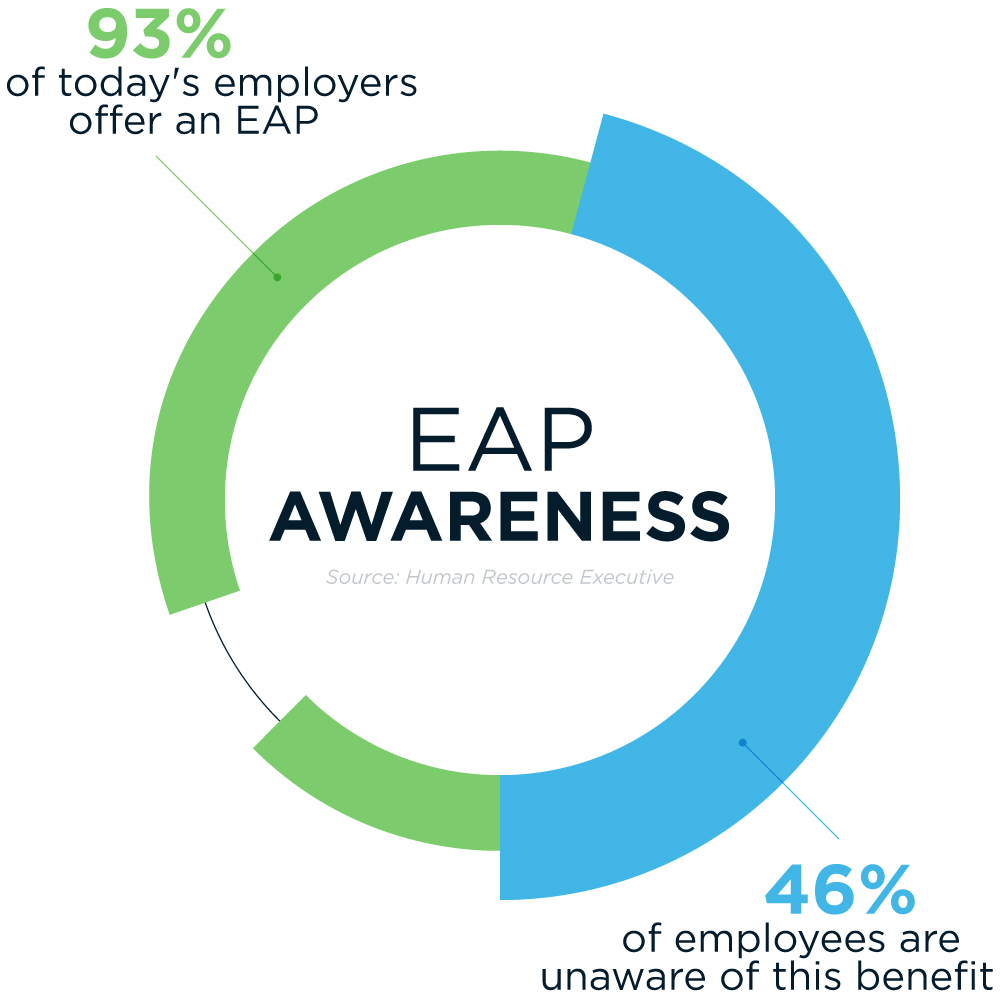Introduction
An employee assistance program (EAP) is a workplace benefit that helps employees address challenges that could negatively interfere with their work performance or everyday life.
Multiple studies have shown that EAPs are a win-win benefit. When employees can find the support they need to manage life’s challenges, organizations are more likely to have an engaged and productive workforce. Other studies have shown that when employees use their employee assistance programs, they are highly satisfied with the services they receive.
Yet, despite the effectiveness of EAP services and their high satisfaction rates, EAPs often remain an overlooked and underutilized workplace benefit.
Statistics About EAP Utilization
When you review EAP utilization rates, you’ll see a disconnect between what organizations offer and what employees think they have. According to a survey cited by Human Resource Executive, 93% of HR professionals said their organization offers an employee assistance program. However, only 54% of the employees surveyed said they were aware of this benefit. The remaining 46% were unaware of their EAP or unsure whether their organization provided this benefit.

Why EAP Utilization is Important
When employees can find the support they need to manage everyday challenges, they tend to be healthier, happier, more focused, and less stressed. Similarly, when employers offer employees access to EAP services, employers are more likely to have an engaged and effective workforce and a healthy workplace culture. This, in turn, enables the employer to focus more time and attention on achieving its organizational goals.
History and Evolution of EAPs
Employee assistance programs (EAPs) have evolved since their inception in the 1930s. Back then, they were introduced as a tool to improve employee productivity and occupational safety by helping people address alcohol abuse.
Over the years, EAP providers have expanded their services to address mental health conditions, relationship issues, and substance abuse. More recently, employee assistance programs added work-life resources to help employees address legal and financial concerns and find referrals for childcare and eldercare.
Some EAPs also provide access to medical advocacy, a service that helps people navigate health insurance, secure medical equipment, and find resources for family members with special needs.
EAP providers continue to evolve and expand their services. For example, today’s leading providers offer auxiliary services to augment their employee assistance programs, such as wellness programs, organizational development, crisis management, and concierge services.
Understanding the obstacles
Recent studies have uncovered several reasons why EAPs remain overlooked and underutilized. Here are some of the most common:
- Employees remain unaware of this benefit. All too often, EAPs are overshadowed by health insurance benefits and retirement benefits. Because EAPs are optional, new hires are not required to sign up for this benefit, making it easier for EAPs to get overlooked during the onboarding process.
- People do not fully understand what their EAP program offers. Many employees know that their EAP provides mental health services. However, they may not know that their EAP offers a more expansive approach to well-being, with services that address mental health, physical health, relationships, financial wellness, and many other issues that impact overall life satisfaction.
- Employees are hesitant to seek outside support services. It’s common for people to value self-reliance when addressing their concerns, thinking they can power through these issues on their own. While time and perseverance can resolve many challenges, reaching out for support can make the process quicker and easier and reassure employees that they’re not alone.
- People are hesitant to seek mental health support. While much progress has been made in reducing the stigma around mental health, biases remain, especially among some demographic groups.
- People worry about their privacy. Employees need to be reassured that their EAP services are completely confidential. No identifying information is provided to the employer. All EAP record-keeping follows federal HIPAA laws, which prevent unauthorized sharing of private health information.
5 Ways to Increase EAP Utilization
To increase EAP usage, it’s helpful when organizations are aware of these obstacles and address them strategically. Here are five ways organizations can boost EAP usage and maximize ROI:
1. Promote EAP Awareness
Introductions are important. Make sure new employees are made aware of this program when they join your organization. Your account manager can provide your human resources department with helpful onboarding tools to inform and educate people about this benefit. These materials should describe all the resources and services included in the EAP benefit and provide clear instructions on how to access them. It’s helpful when these materials can be shared digitally or as handouts and are available in English or Spanish.
If your organization selects a new EAP provider, make sure your account manager introduces the program to your entire organization–employees and leadership teams–and thoroughly explains how EAP services have evolved over the years, to address not only mental health issues but also life’s many other stressors.
Reminders throughout the year are equally important. Look for an EAP provider that offers monthly newsletters and webinars. These year-round promotional tools increase EAP awareness, boost employee engagement, and inspire people to take a more active role in strengthening their mental health and overall well-being.
Remind human resources and leadership teams about critical incident support. A critical incident is any sudden, unexpected, and potentially traumatic event that may significantly impact employees or the workplace environment. Examples include workplace accidents, acts of violence, natural disasters, an impending layoff, or a colleague’s death or illness.
EAP account managers have the knowledge, resources, and networks to help organizations during times of crisis. To ensure a timely response, make sure your human resources department and leadership teams are aware of critical incident support services and know how to access their account manager.
2. Provide Easy Access
Since COVID-19, healthcare delivery has evolved considerably. For example, people have grown more accustomed to accessing online tools, resources, and assessments. However, there still are times when people crave human guidance and connection.
To make it easier for people to receive the type of services they want and need, especially during times of crisis, look for an EAP program that provides services to employees and their family members and different ways to access them. Today’s leading EAP providers offer the following:
Phone access, 24/7/365. Sometimes people need to speak with a real human who can provide timely guidance, referrals, and in-the-moment support. Make sure your EAP offers 24/7/365 telephone access and provides the phone number and access code on all employee onboarding materials.
Live chat. People appreciate the convenience of live chat, which works much like texting. Today’s leading EAP providers tend to provide this live chat feature through the EAP’s member portal, with access available Monday through Friday, from 8 a.m. to 5 p.m. ET. If an employee is in crisis, they will be referred to in-the-moment counseling provided over the phone.
Online request forms. People also appreciate the option of being able to request mental health counseling or work-life resources and referrals by filling out and submitting an online form. Today’s leading EAP providers offer this feature through their online member portal, enabling people to request EAP services 24/7/365.
Many people have also developed preferences for how they receive counseling services. It’s helpful when an EAP offers in-person sessions, video sessions, phone sessions, live chat sessions, and asynchronous messaging (which allows an individual to pause and continue the conversation at their convenience).
3. Normalize EAP Usage
Make sure everyone understands that their EAP is part of your organization’s larger initiatives. By supporting the mental health and well-being of your employees and their family members, your organization is more likely to benefit from a healthy workplace culture and an engaged and productive workforce.
4. Train Managers and Supervisors
Make sure your EAP program provides access to a dedicated account manager. These professionals work with organizations to help launch the EAP program and support leadership teams throughout the years by offering consultations and addressing concerns as they arise. These may involve policies related to the EAP, making formal and informal referrals, and providing critical incident response services.
5. Evaluate and Adjust
Ask your account manager to provide information on EAP usage rates and seek input from your leadership teams on employee engagement and performance. Does it appear that employees have the support they need to manage life’s challenges? How is your workplace culture?
It’s helpful to note that employee assistance programs (EAPs) are not always the best solution for every problem. For example, when people struggle with systemic issues embedded within the organization itself, EAPS can help people manage the stress related to these concerns. However, they are not the right tool for addressing the underlying issues causing this stress.
Examples of larger systemic concerns embedded within the organization include poor leadership, operational bottlenecks, short-staffing, bullying, and other concerns related to workplace culture. In these cases, an organization may want to seek organizational development services.
The AllOne Health Difference
When looking for an EAP provider, it’s helpful to look for an organization willing to support your organization at every level: Employees. Managers and supervisors. Human Resources. And the C-suite.
With over 50 years of experience, AllOne Health is the premier provider of whole health solutions for organizations worldwide. Our solutions include reimagined employee assistance programs, organizational development services, crisis management, wellness, and concierge.
For more information or to request a free quote from our sales team, click here.


